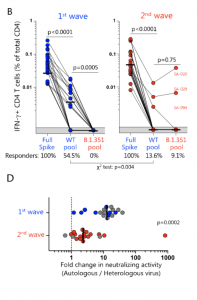
Loss of recognition of SARS-CoV-2 B.1.351 variant epitopes and neutralizing antibody responses. (B) Summary graphs of the frequency of IFN- -producing SARS-CoV-2-specific CD4 T cells in first wave (n = 22, left) and second wave (n = 22, right) COVID-19 patients. The proportion of patients exhibiting a detectable response to the different peptide pools (i.e., responders) is indicated at the bottom of each graph. (D) Fold-change in neutralization titers of plasma samples from COVID-19 patients recruited during the first wave (n = 18) or the second wave (n = 19) were tested for their neutralization cross-reactivity against the ancestral or B1.351 pseudoviruses. Bars represent medians. Statistical analyses were performed using the Wilcoxon test and the chi-squared test.
The majority of our knowledge of how pre-existing SARS-CoV-2 immunity induced by infection or vaccination responds to emerging SARS-CoV-2 variants of concern (VOC) has largely focused on the neutralisation capacity of antibodies. These studies demonstrated that SARS-CoV-2 VOCs can partially overcome pre-existing immunity resulting in infection despite robust immune responses. (Read more: Do mutations in SARS-CoV-2 variants reduce the functional activity of mRNA-vaccine elicited Abs?, Mutations in SARS-Cov-2 B.1.351 variant reduces vaccine induced Ab neutralisation ). However, many studies have demonstrated that T cells also play an important role in SARS-CoV-2 immunity (Read more: SARS-CoV-2-specific Memory B cells persist up to 8 months post infection; HIV-1 and TB coinfection skews the SARS-CoV-2 T cell response. ) In a recent preprint, Riou and colleagues aimed to provide an overall measure of immune evasion by assessing neutralizing antibody and T cell responses in 44 South African COVID-19 patients infected either with B.1.351 or infected before its emergence (‘first wave’).
Results from their study demonstrated a significant reduction of antibody neutralising cross-reactivity to B1.351 pseudoviruses, as well as the magnitude of T cell responses to SARS-CoV-2 epitopes that contained mutations in the B.1.351. Interestingly, T cell immune responses to the mutated spike protein only represent s 15.7% of the total CD3 T cells responses. Thus despite the loss of recognition of immunodominant CD4 epitope(s), overall CD4 and CD8 T cell responses to B.1.351 are preserved.
Researchers suggested that these observations may explain why, despite the substantial loss of neutralizing antibody activity against B.1.351, several vaccines have retained the ability to protect against severe COVID-19 disease.
Summary by Cheleka AM Mpande










